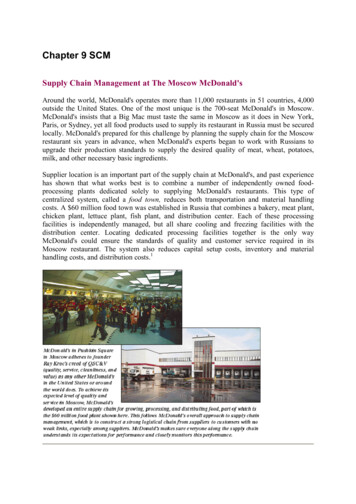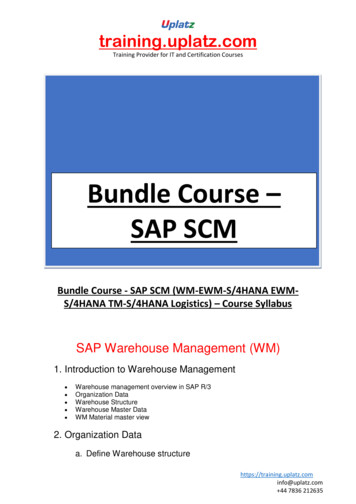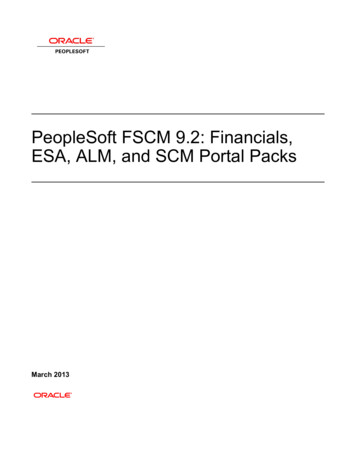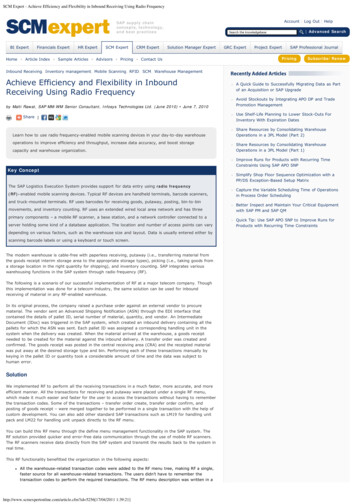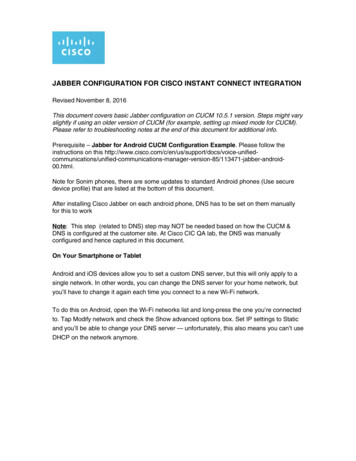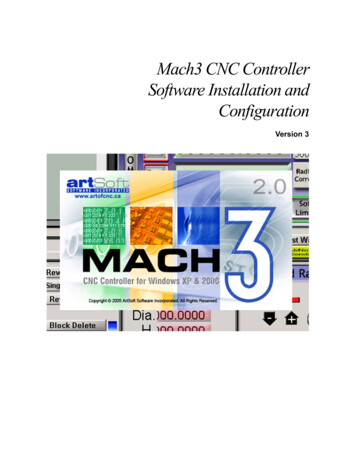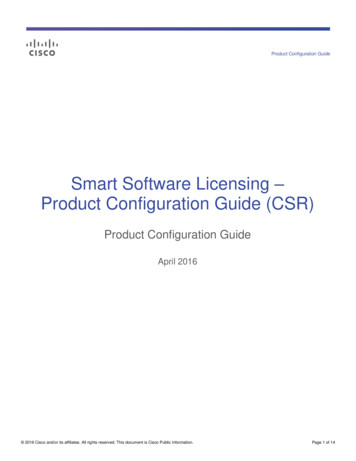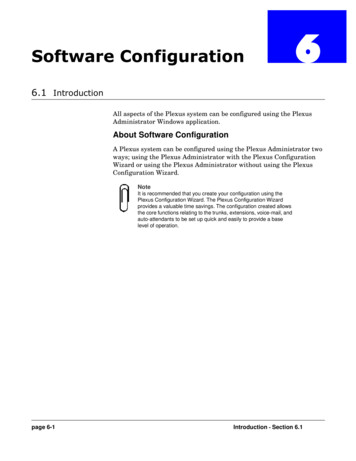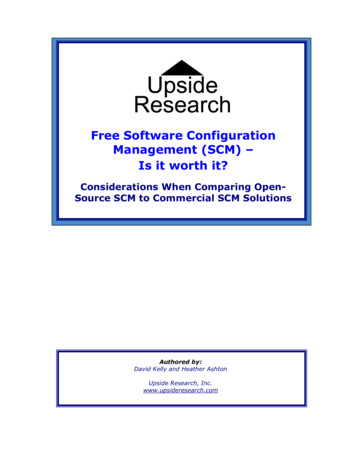
Transcription
dFree Software ConfigurationManagement (SCM) –Is it worth it?Considerations When Comparing OpenSource SCM to Commercial SCM SolutionsAuthored by:David Kelly and Heather AshtonUpside Research, Inc.www.upsideresearch.com
Free Software Configuration Management-Is it worth it?Contents Executive SummaryThe market for software configuration management (SCM) tools is filled with an array of products andsolutions. Before selecting an SCM tool, it is important to understand exactly what the impact of thatproduct can have on your development environment. This paper assesses the potential impact of opensource and commercial SCM tools in five selected areas of evaluation. Methodology and Definitions for the ReportThis paper is based on research conducted by Upside Research with software vendors and multipleenterprise developers and managers responsible for mission-critical source code. When Open Source Makes Sense and When It Doesn’tThe important thing to remember when using open-source tools for a development effort is that if thescope of the project creeps beyond the initial outline, or the project continues to grow and morph into amuch larger project (as many development efforts have been known to do) there are a number of issueswith the development process and the SCM tools that support it that must be considered. A Typical Scenario for SCM Tools: The Real Costs and BenefitsThis section is designed to help companies evaluate the true cost of an SCM solution. It takes a closer lookat the experience of a consumer services company in the travel sector with both open-source andcommercial SCM solutions, and the costs and benefits the retailer experienced. ConclusionEffectively managing the development effort is critical for the ultimate success of any project. Having theright toolset to support this effort is often the key to maximizing development resources. SCM tools play acritical role in this toolset and determining the best fit for your development process is an importantdecision to make. While open-source SCM tools are readily available and free for the taking, it is importantto understand that they may not be free for your organization in the long run.Copyright 2011, Upside Research, Inc., which is solely responsible for its content. All rights reserved.No part of this report may be reproduced or stored in a retrieval system or transmitted in any form orby any means, without prior written permission. Disclosure statement: This report was sponsored by,and may be licensed to, a limited number of commercial software vendors. No quotes or informationcan be excerpted or used without explicit written permission from Upside Research, Inc. 2011 Upside Research, Inc.i
Free Software Configuration Management-Is it worth it?Executive SummarySoftware Configuration Management (SCM) is a critical core infrastructure tool for allsoftware development organizations. The right SCM solution helps organizations by helpingthem: improve product quality and customer satisfaction; meet product time-to-market and revenue goals; comply with government and industry regulatory requirements; protect key corporate assets; manage increasingly complex and evolving development processes, and much more.While often taken for granted or below senior management’s radar, SCM is an extremelyimportant component of an organization’s software infrastructure.Historically, a significant number of organizations have used open-source SCM, such asRCS, CVS and more recently Subversion, to form the backbone of their developmentenvironments. However, such solutions can have hidden costs associated with them. Thispaper was written to help organizations understand when such free tools make businesssense and when commercial SCM solutions may be more appropriate. We wanted to ask thequestions that senior management should be asking themselves: How do I know if open-source SCM is right for my organization? What risks am I exposing my organization to by using open-source SCM? What are the true hidden costs of open-source SCM?In this report we provide context for answering those questions and analyze a compositescenario of an organization that has used both types of solutions, based on interviews withenterprise developers and industry research.While our findings show that open-source SCM is undeniably a valid option for certaincompanies and certain types of projects, it can also be a very expensive option once all thehidden costs and limitations are added in. In addition, open-source SCM can also harborhidden risks and costs that may be considered unacceptable to many organizations giventhe demands of today’s global and compliance-driven business environment. Such risks mayinclude: the need for time-intensive (and potentially error-prone) scripting required forproper implementation; the exposure of having someone new assume the management ofthe tool when turnover occurs; and the compliance failure resulting from the inadvertentand the malicious deletion of history/artifacts in the tool (deleting history is a practice whichmany open-source SCM tools allow). Organizations considering open-source SCM solutionsto meet tactical or strategic project needs should pause and consider the implications ofsuch solutions on the long-term efficiency and effectiveness of their development processes.Of course, at the most basic level, commercial SCM products cost more initially, at leastfrom a purchasing standpoint. There are also on-going hard costs (such as maintenance 2011 Upside Research, Inc.1
Free Software Configuration Management-Is it worth it?fees) and soft costs (such as administration or management resources) that need to befactored into a purchase vs. open source decision.Upside Research knows that the market for SCM tools is filled with a wide range of bothopen-source and commercial solutions. This paper assesses the potential impact of opensource and commercial SCM tools on five critical areas of evaluation in order to providegreater insight into the potential costs and/or benefits associated with any given solution.Upside Research suggests that development teams and managers use this document as astarting point for determining the best SCM tool fit for their requirements.METHODOLOGY AND DEFINITIONS FOR THE REPORTThis paper is based on research conducted by Upside Research with multiple enterprisedevelopers and managers responsible for mission-critical source code and software vendors.The paper is intended to highlight a select number of issues that organizations need toconsider when evaluating either open-source or commercial SCM packages and helporganizations understand the associated potential costs or benefits. We suggest thatreaders use this report as a basis for constructing their own case for investment in a specificcommercial package or as the justification behind why open-source or freeware SCM willmeet both current and future needs. Within large and small development organizations, thisreport will benefit release engineers, senior developers, SCM leads, project leaders,managers, architects, and anyone that needs to evaluate solutions for long-term viabilityand not just for single, one-off projects.For the purposes of this report, we are calling open-sourceand free solutions (SCCS, RCS, CVS, Subversion) ―opensource SCM‖ and commercial solutions (AccuRev, Borland,IBM Rational, Serena, Telelogic, etc.) ―commercial SCM.‖WHEN OPEN SOURCE MAKES SENSE ANDWHEN IT DOES NOTOpen-source SCM tools are often a preferable option fororganizations in certain situations. When a developmentproject involves a small team and is limited in scope, mostcommercial SCM tools are overkill. It would take just aslong to finish the development of the new project as itwould to get up and running with the commercial SCMtool. Therefore, using an open-source SCM tool in thiscase makes perfect sense. Other factors that point towardopen source include either limited (or no) paralleldevelopment or a team of developers that are allphysically located together. Upside Research has spokenwith several large enterprises that have validated thesuccessful use of open-source SCM tools in these types ofsituations with good results. In almost every case, these 2011 Upside Research, Inc.2When Open Source May NotBe EnoughHow well does the open-sourceSCM tool support theserequirements? Advanced paralleldevelopment environments Controlled distributeddevelopment The need for atomic saves More than ten-persondevelopment projectssharing common code Mission-critical orcommercial softwaredevelopment Multiple branches andmerges Complex repositorystructure Need for reproducibility Regulatory compliancerequirements
Free Software Configuration Management-Is it worth it?companies also had licenses for commercial SCM products, but found that for the fast andstraightforward development projects, using an open-source tool proved more efficient andcost effective. To help provide context, Upside Research urges companies to consider thefollowing issues related to SCM deployment:Scope – When using SCM products it’s particularly important to consider the potential forthe scope of a project to creep beyond the initial requirements and the potential for theproject itself to grow and morph into a larger project (as many development efforts havebeen known to do). Increasing the complexity of or size of a project can have a dramaticeffect on the true cost and resources required to make an open-source SCM solution workefficiently. There are large enterprises that have found themselves years after adopting a―free‖ open-source SCM tool still trying to make it work. And, while technically such toolswill work, the associated costs of having to make them fit into a team of tens or hundreds ofdevelopers when once there were five may be simply impractical.Responsibility - Who will manage the scripting/customization and upgrades for the opensource tool? When a commercial tool is purchased, it often has direct ownership tied to it forthe purposes of upgrades, maintenance, and management. However, the responsibility foran open-source tool often falls in the lap of whoever initially downloaded the product andbrought it to the development team. If the project has grown and now the open-source SCMtool has been in use for enough time that there are upgrades available, that same developerwho brought the tool to the table now must manage and administer it, which invariablymeans less time spent on actual development. The task of managing both the tool and theassociated scripting can be especially daunting as the organization scales.Scripting - The common thread in our research is that the costs of customizing the opensource SCM tool are often drastically underestimated when the team first begins using it.Where does the tool stop and the scripting begin? Often teams find themselves up to theirelbows in scripting when they assumed at the outset that the customization needed wouldbe minimal. Another common and underestimated outcome is that the developmentorganization ends up modifying its development process to conform to the limitations of theopen-source SCM tool, especially with respect to supporting branching and mergingoperations, which often causes non-trivial costs related to reduced developer productivityand/or software quality.Compliance - Compliance is another area that must be considered when making a decisionabout open-source SCM. How much risk are you willing to allow into your developmentenvironment? For companies that have classified development efforts, choosing an opensource solution may open the door for levels of risk that are simply unacceptable. Becauseof the nature of open-source, there is no protection from some malicious entity contributingto the open source code and potentially causing significant harm. While not a day-to-dayproblem, the level of acceptable risk from an open-source solution is something that needsto be weighed against the benefits of using an open-source tool. 2011 Upside Research, Inc.3
Free Software Configuration Management-Is it worth it?The above issues are often overlooked by many development groups when looking at therelative simplicity and convenience of an open-source SCM tool when compared to acommercial package. Only after using the tool for a while, when it is considered part of thefabric of the development project, does it suddenly cross over into the category of overheadburden and administrative challenge.Keep in mind that the considerations we raise in this report must be put into context withinyour specific deployment scenario. For example, open-source SCM solutions may work wellfor even large companies with 100 or 200 developers, if their use fits the constraints of thetools—such as if the development organization is organized into 20 smaller teams that don’twork with overlapping source code.To assist organizations in evaluating whether they are at the point where an alternative toopen source makes more sense, Upside Research has taken a closer look at several majorareas of SCM tool functionality to help organizations in their evaluation process.A TYPICAL SCENARIO FOR SCM TOOLS: THE REAL COSTS/BENEFITSTo help organizations evaluate the true cost of an SCM solution, Upside Research spoke witha number of enterprises currently using open-source and commercial SCM tools. We learnedfirst-hand about the real costs and benefits realized by these organizations. The followingrepresents a typical scenario of how one company fared, offering examples of the majorcategories for consideration when adopting an SCM tool.The company is a major consumer services provider in the travel sector whose businessruns on its web-based software applications. Because the code is the business, developersand the management of the development processare central to this organization’s success. Over theThe Human Risk:course of several years, the company grew fromAnEmployeeTurnover Examplefewer than 50 to more than 300 developers, andThe developer that ―owned‖ the toolwas hitting the wall with its open-source SCM toolwas able to make minor fixes orwith the following costs/challenges:enhancements in a few days or within Branching and merging. When the opena week. He also had intimateknowledge about how to fix thingssource tool was first introduced, there werewhen there were problems. When hea manageable number of branches requiredleft the company, there was a hugeto meet the needs of the developmenthole in his absence. Suddenly, thoseminor fixes were taking weeks orenvironment. However, at its height, theremonths. The tool needed to bewere more than 200 branches off the mainupgraded, and it was a ―completecode branch. At that point, the open-sourcenightmare‖ for the new developer, whohad to try to migrate all of thetool could not keep up with the merges thatcustomizations without understandingwere taking place and as a result, twotheir genesis.developers had to be redirected for twoweeks straight to do a manual merge, at acost of more than 12,000 for a majormerge tied to a code release. 2011 Upside Research, Inc.4
Free Software Configuration Management-Is it worth it? Auditing. At the beginning, when the development team was small and the processfairly straightforward, no one gave much thought to merge history and auditing.However, as the complexity grew, it became increasingly important to track mergesto determine what had been merged, and which developers were responsible forwhat code. This was an attempt to stay on top of the complexity and ensure thatmerges were successful. The development team found itself wasting up to threeweeks researching audit requests, which put another significant dent in productivity.Change sets. The open-source SCM tool that this company was using didn’t supportchange sets. As a result, the developers were working overtime trying to track downpatches and ensuring that they were made in all the necessary areas. The costsadded up to more than 10,000 annually.Global view of project. Having a global view (or graphical view) of thedevelopment efforts was seen as important in order to optimize the performance ofthe team. Without this, this company was seriously challenged by the 200 activebranches within the project. Developers had little insight into the larger projectpicture which led to the habit of ―throwing it over the wall‖ with their current work.This proved to be a primary reason why the company decided it needed acommercial SCM tool.Distributed development. As the company grew, it outsourced development tomore cost-effective geographic locations in order to reduce development expenses.This meant that there were now developers located across the globe, contributing toa common source base 24/7. The open-source SCM tool that they were using did noteffectively support distributed development. The code review process waschallenging as a result, and often the developers had to resort to time-intensivebrute force methods to manage off-shore contributions, where a developer that wasintimately familiar with the structure physically checked in code to the intendedbranch.Vendor support and upgrade path. While in the beginning there wasn’t muchoverhead associated with managing the open-source tool, the development teamfound that this changed significantly with time. The developer who initially brought inthe tool found that over four years he had spent as much as 50% of his time doingcustom integrations and upgrades. There were few, if any, outside sources ofsupport that he could tap into, and this significantly curtailed his productivity. 2011 Upside Research, Inc.5
Free Software Configuration Management-Is it worth it?The Real Costs of Open-source SCM For This Development OrganizationCategoryCostMergingMore than 12,000 per major merge 60,000 annuallyAuditing3 weeks of developer time doing audit research 9,000Change setsMore than 10,000 annually tracking down patchesVendor support andupgrades 40,000 annually for one developer to spend half his timemanaging integrations and upgradesTotal costs* 119,000 per year to use the open-source SCM toolTHE COMMERCIAL SOLUTION AND ITS BENEFITSThis company chose a commercial SCM tool to replace its open-source tool, andimmediately saw a considerable gain in productivity and cost savings. There were a numberof areas where the new tool proved beneficial and made positive contributions to thedevelopment effort. Here’s a closer look at the benefits: Continuous merging. With the new tool, the development team began to adapt toa continuous approach to development, where they were continually mergingchanges. This prevented errors from making it through to the end of codedevelopment and throwing the team back weeks. Audit history. Shortly after implementing the new SCM tool, the development teamwas able to test its audit capabilities. It had an audit request, and using the new toolwas able to complete it in 2 hours, instead of the three weeks it used to take. Graphical view. The developers really appreciated the new global view of theproject. This was especially critical for new hires, who were able to use the globalview of the project to get up to speed quickly, saving an average of two weekstraining per developer. Distributed development. With the new tool, the team was able to use an existingdeveloper located in India instead of hiring a new developer in the US for 80,000annually. Custom integrations and upgrades. The commercial tool provided full vendorsupport and a number of pre-existing integrations, saving 50% of the time the leaddeveloper spent managing the open-source tool.*These are the immediately identified costs that were eliminated when the company moved to the commercial SCMtool. The actual total costs, which involved set-up, scripting, upgrading/maintenance, training, support, etc. wereconsiderably higher. 2011 Upside Research, Inc.6
Free Software Configuration Management-Is it worth it?The Real Bene
Open-source SCM tools are often a preferable option for organizations in certain situations. When a development project involves a small team and is limited in scope, most commercial SCM tools are overkill. It would take just as long to finish the development of the new project as it would to get up and running with the commercial SCM tool.


